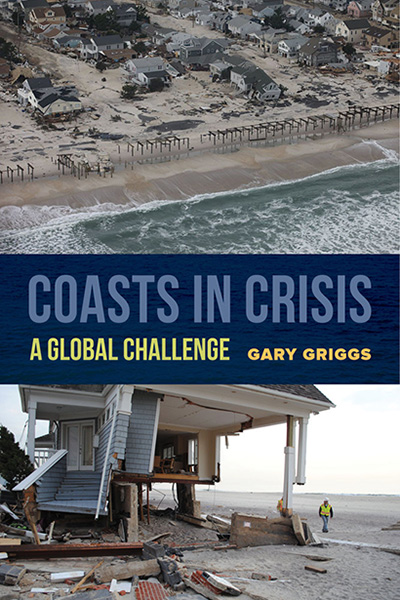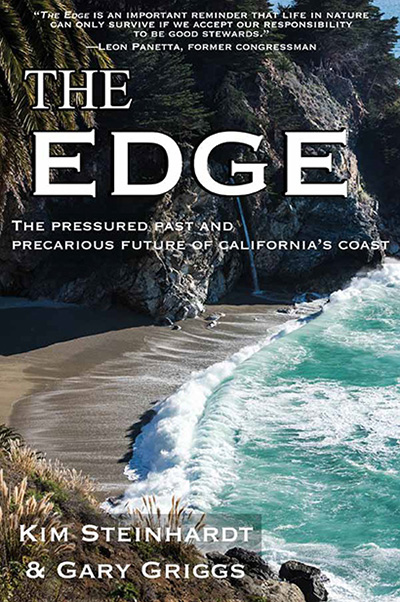Gary Griggs has been writing and teaching about coastal issues since he arrived at UC Santa Cruz fifty years ago as a young assistant professor. Now a distinguished professor of Earth and planetary sciences, Griggs has published two new books this year.
Coasts in Crisis: A Global Challenge (UC Press, September 2017) dives headfirst into the geological and historical conditions that have brought three billion people to occupy and exploit the world’s dynamic coastlines. According to Griggs, sea level rise may be the greatest challenge human civilizations have ever faced globally.
In The Edge: The Pressured Past and Precarious Future of California’s Coast (Craven Press, October 2017) Griggs and coauthor Kim Steinhardt explore California’s captivating coastal edge from past to present and look ahead to its uncertain future. The book shines light on how climate change, fisheries, petroleum industries, and coastal development intertwine to transform coastal communities, and it explains how decisions made today will shape the coasts of tomorrow.
These are the ninth and 10th books Griggs has published in a long-running effort to raise public awareness of issues involving the oceans and coasts. He also writes a regular column, “Our Ocean Backyard,” for the Santa Cruz Sentinel. A side project that Griggs originally believed would last for only a few months, the column is now on its ninth year.
“If you write the right thing at the right time you can have a profound impact,” Griggs said. “Writing for the Sentinel for the past nine years has been fun. It taught me how to write so the public can understand.”
Sea level rise
The threat of sea level rise, driven by climate change, as well as the growing populations concentrated in coastal areas are central concerns of Coasts in Crisis. The global average sea level is expected to be one foot higher by 2050 and will likely be three to five feet higher by 2100, leading to unprecedented levels of coastal flooding, erosion, and storm damage. Sea level rise intensifies the impacts of storm surge, making short-term weather events more dangerous, as seen in the devastation and lives lost from Hurricane Katrina (2005), “superstorm” Sandy (2012), and this year’s hurricanes Harvey and Irma.
In addition to opening readers’ eyes to the many natural hazards that impact the hundreds of millions of people living within three feet of the high-tide line, Coasts in Crisis offers recommendations at the end of each chapter for how governments and individuals can take action. The book also addresses the impacts of civil engineering tools such as seawalls used to protect property from erosion, desalination for drinking water, use of seawater to cool coastal power plants, and coastal wind farms for harvesting renewable energy.
People love the coasts for their beauty and recreational opportunities, but they are also where people dump waste and extract resources. “The ocean has a memory, and you can’t just keep dumping and expect it not to respond,” Griggs said. “Corals are dying as the ocean is becoming more acidic. We need to be aware of those impacts. It is a global issue.”
Lifelong connections
The Edge is more recent and more personal than Coasts in Crisis. The first two chapters touch on the authors’ childhoods and lifelong connections to the coast, but the book still has a hard-nosed focus on coastal challenges, both past and present. Subjects include early and recent human migration, offshore drilling, fishing, and neighborhoods lost to the ever-eroding edge that is California’s coastline. The book looks back in history at political clashes over protection of the coastal environment and at the policies that have made California a model to the world for coastal protection.
Griggs’s friend and coauthor Kim Steinhardt is a retired administrative judge with years of coastal policy experience and a particular interest in sea otter conservation. Steinhardt is also an accomplished photographer whose pictures have appeared in National Geographic children’s books. The Edge has 125 captivating images of California’s expansive, changing coastlines and diverse wildlife, including many of Steinhardt’s wildlife photos and Griggs’s pictures documenting geological processes and hazards.
The Edge illustrates how California came to be such an important edge, where early human populations and later European immigrants found abundant resources, including fish and wildlife thriving in the rich coastal waters. It chronicles the boom and bust cycles of California’s fisheries, the erosion of sand from beaches, and the uncertain recovery of the sea otter population. At the same time, the book’s personal approach forced Griggs and Steinhardt to talk more deeply about their understanding and appreciation of the coast.
“It is a personal piece, more so than my other books,” Griggs said. “To have two books come out in one year, well, it just happened that way.”
Griggs and Steinhardt will discuss The Edge in a public talk and book signing at the Seymour Marine Discovery Center on Friday, November 3, from 6:30 to 8 p.m.




